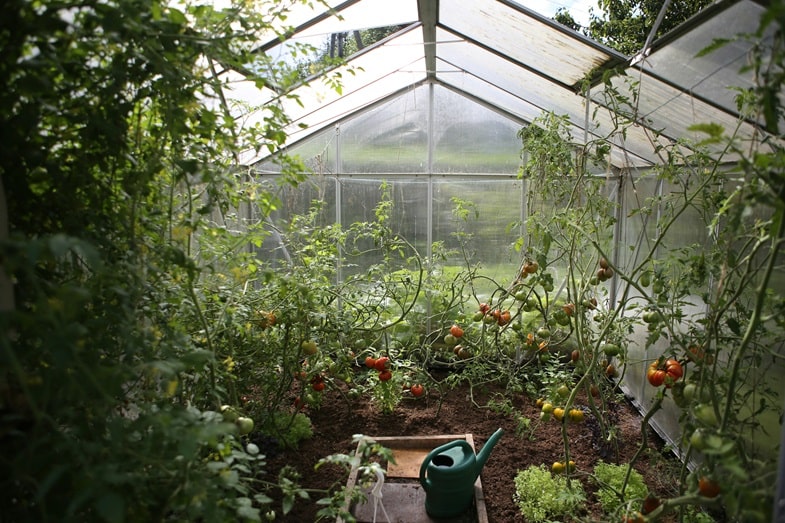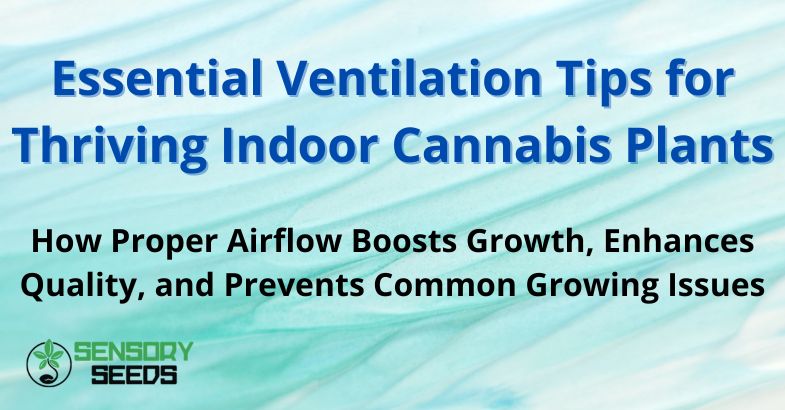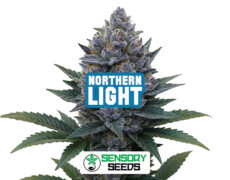Published on: 27/12/2024
How Proper Airflow Boosts Growth, Enhances Quality, and Prevents Common Growing Issues
When it comes to indoor cultivation, many people focus on aspects such as lighting, nutrients, and soil, often overlooking a fundamental element: ventilation. Ensuring proper air circulation in the grow environment is essential for the health and optimal growth of the plants, directly affecting the yield, the quality of the buds, and resistance to diseases and pests.
In this article, we will delve into the importance of ventilation in indoor cannabis seeds cultivation, examining how and why this aspect is crucial to the success of your grows.
Ventilation: A Key Factor in Indoor Cultivation
Indoor cannabis cultivation allows growers to have full control over the plants’ growing environment. However, with this control comes the responsibility to recreate all the necessary conditions for the plant to thrive. Among these factors, ventilation plays a primary role. It’s not just about keeping the plants cool: proper ventilation affects various aspects of growth, including photosynthesis, transpiration, humidity management, and the prevention of issues like mold and infestations.
Without adequate ventilation, plants can suffer from several problems that slow down growth or, in the worst cases, completely compromise it. Stagnant air conditions create an environment conducive to the proliferation of fungi and bacteria, reduce the concentration of available CO2, and increase heat stress. For this reason, it is essential to adopt a ventilation system that not only removes hot and humid air but also promotes a constant flow of fresh air rich in CO2.
Read also: Indoor cannabis seeds: strengths and weaknesses of these seeds
The Benefits of Ventilation: From Oxygenation to Disease Prevention
Ventilation works on multiple fronts, providing benefits that range from more vigorous plant growth to disease prevention. One of the first advantages is the improvement of photosynthesis, the process through which plants convert light into energy. Photosynthesis requires not only light and water but also carbon dioxide (CO2). A well-ventilated environment ensures that the plants receive a constant flow of CO2, crucial for supporting rapid and healthy growth.
Another important aspect is humidity regulation. When the air becomes too humid, it creates an ideal environment for mold formation, such as Botrytis (gray mold), which can destroy entire crops. Additionally, excessive humidity hinders plant transpiration, the process by which plants release excess water through their leaves. Transpiration is essential for cooling the plant and transporting nutrients, and poor humidity management can lead to waterlogging that suffocates the roots and causes root rot.
Furthermore, ventilation helps reduce excess heat that can accumulate in the indoor environment, especially when using powerful grow lights. High temperatures can cause heat stress, slowing growth and damaging the leaves. A constant flow of air helps dissipate excess heat, keeping the temperature at ideal levels for growth.


The Balance Between Temperature and Humidity
Another key aspect of ventilation is controlling the relationship between temperature and humidity, often referred to as VPD (Vapor Pressure Deficit). VPD represents the balance between the amount of moisture in the air and the air’s capacity to hold moisture at a given temperature. This ratio directly affects plant transpiration, and thus their ability to absorb water and nutrients.
When humidity is too low, plants transpire more quickly, which can lead to dehydration and excessive water consumption. Conversely, when humidity is too high, transpiration slows, and plants may accumulate excess water, increasing the risk of fungal diseases. Good ventilation helps maintain VPD within an optimal range, improving the overall health of the plants and maximizing yield.
Types of Ventilation: Natural vs. Mechanical
There are two main types of ventilation used in indoor cannabis cultivation: natural ventilation and mechanical ventilation. The choice between the two mainly depends on the size and configuration of your grow space.
Natural Ventilation
Natural ventilation relies on the simple principle of air exchange between the inside and outside of the grow space. By opening windows, doors, or vents, fresh air can enter, and warm air can exit, facilitating continuous air exchange. This method is only effective in very small grow spaces or in areas with good sources of natural ventilation. However, natural ventilation has some limitations. For example, the airflow may not be consistent, and in extreme seasonal or climatic conditions (intense heat or cold), it may be difficult to maintain a stable environment for the plants.
Mechanical Ventilation
Most indoor growers opt for a mechanical ventilation system, which guarantees precise and constant control of the airflow. A typical mechanical system includes exhaust fans, oscillating fans, and carbon filters to ensure an optimal environment. The exhaust fan extracts warm and humid air from the grow space, while the oscillating fans move the air inside, ensuring that each plant receives the proper airflow. A well-designed mechanical ventilation system allows you to adjust the airflow rate based on the plants’ needs at each stage of the growth cycle. For example, during the vegetative stage, plants may require less ventilation compared to the flowering stage, when heat and humidity production increases.
The Elements of an Efficient Indoor Ventilation System
To design an efficient ventilation system for your indoor grow, several key factors must be considered that affect the quality and flow of air. These include the size of the grow space, the power of the lights, the number of plants, and the type of equipment used. Here are some of the main elements to consider:
- Exhaust Fan: This device extracts air from the grow environment, promoting the entry of fresh air. It’s important to choose an exhaust fan that is the right size for the grow space. The airflow capacity (measured in m³/h) should be sufficient to ensure a complete air exchange every 3-5 minutes.
- Oscillating Fans: These are essential for keeping the air moving inside the grow space. Oscillating fans help distribute air evenly around the plants, preventing stagnant zones and cooling the leaves evenly.
- Carbon Filters: These filters are used to purify the outgoing air, removing odors and harmful particles. Activated carbon filters are essential to prevent the smell of cannabis from spreading outside the grow space, in addition to improving air quality for the plants.
- Passive Air Intakes: Passive air intakes allow fresh air to enter the grow space when the exhaust fan extracts warm air. It’s important to place these intakes near ground level, as cooler air tends to settle lower.
Ventilation in Relation to the Different Growth Stages of Cannabis
Each growth stage of cannabis requires a different approach to ventilation. From germination to harvest, the intensity and type of ventilation must adapt to the plants’ specific needs at each stage.
Germination and Vegetative Stage
During germination, plants are delicate and do not require excessive airflow. A light fan may be enough to maintain a moderate air flow. The main goal at this stage is to avoid stagnant air and maintain a consistent humidity level, which helps with germination and rooting.
In the vegetative stage, plant growth accelerates, and CO2 absorption increases. At this stage, it’s important to ensure that the plants receive an adequate amount of CO2 to support photosynthesis. A constant airflow will also help strengthen the plant stems, preparing them for the flowering stage.
Flowering Stage
During flowering, plants begin to produce buds, which are highly sensitive to humidity and heat. It’s essential to maintain a lower humidity level to prevent mold formation, especially as the buds become denser. At this stage, a powerful ventilation system becomes indispensable to keep the air fresh and dry, avoiding issues related to humidity.
Additionally, odor control becomes crucial during flowering of indoor cannabis, as it emits strong aromas. Activated carbon filters are essential for keeping the air clean and preventing odors from spreading outside the grow environment.


Common Indoor Ventilation Mistakes and How to Avoid Them
Despite the importance of ventilation, many novice growers make mistakes that can compromise plant growth. One of the most common mistakes is underestimating the size of the ventilation system. Often, growers purchase exhaust fans and oscillating fans that are too small for the grow space, leading to insufficient air exchange and a buildup of heat and humidity.
Another common mistake is not positioning the fans correctly. Many growers place the fans too close to the plants or in spots that don’t promote good air circulation. It’s important that air flows freely around and between the plants, avoiding dead zones where stagnant air can accumulate.
Read also: Marijuana, hours of light and dark: the best cycles for indoor cultivation
Conclusion
In conclusion, ventilation is one of the most critical elements in indoor cannabis cultivation. A well-ventilated environment not only promotes vigorous plant growth but also helps prevent common problems such as mold, root rot, and pest infestations. To get the most out of your plants, it’s crucial to invest in an adequate ventilation system and constantly monitor air, temperature, and humidity conditions.
Looking to enhance your indoor cannabis cultivation? Visit Sensoryseeds for expert advice, premium seeds, and everything you need to optimize your grow setup!









